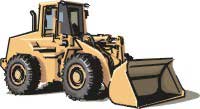Summary Statement
Information on how to handle a backhoe/loader safely, including clothing to wear, checking the machine prior to operation and operating it safely.
|
|
BEFORE USING THE MACHINE
- Read the owner's manual to learn the characteristics of your machine.
- For your personal
protection you will need to wear some or all of the following:

- sturdy pants and shirt,
- safety shoes,
- hard hat,
- safety goggles or glasses,
- gloves,
- hearing protection, and
- respirator
for dusty conditions.
- Sunscreen protection is vital in bright sunshine if not under a roof.
- Check the loader/backhoe
for the presence of the following safety devices in good working order:
- rollover protective structure (ROPS),
- seat belt (if ROPS equipped),
- guards,
- shields,
- backup warning system,
- lights, and mirrors.
- Fill the fuel tank while engine is off and cool. Never fill inside a building. Do not smoke. Wipe up any spills immediately.
- Check the machine daily for broken, missing, or damaged parts. Make the necessary repairs or replacements.
- Keep the machine clean -- especially steps, hand rails, pedals, grab irons, and floor of the cab. Slippery surfaces are very hazardous.
- Remove or secure loose items in the cab that could interfere with operating the controls.
- Check the work area for hidden holes, obstacles, drop-offs, etc. Clear children, pets, and bystanders from the area.
- Check overhead for utility lines, roofs, and other obstacles.
- Request Blue Stake service to locate underground cables, gas lines, water, and sewer lines before digging. You need to request this service in advance.
- Always use the hand rails, ladders, and steps provided when mounting the machine; never grab controls or the steering wheel.
- The cab was designed for one person -- allow no riders, especially children.
OPERATING THE LOADER
 |
|
OPERATING THE BACKHOE
- Keep the loader bucket on the ground.
- Level the machine for maximum stability.
- Operate the backhoe only from the seat.
- Never swing the bucket over a truck cab.
- Dump the bucket uphill if possible when operating on a slope. If you must dump downhill swing slowly to avoid tipping the machine.
- If using the backhoe as a hoist, do so with the weight over the back of the machine -- NEVER THE SIDE -- to avoid tipping.
- Be sure the load you are lifting is balanced, and move the boom slowly to avoid swaying the load.
SAFE STOPPING PROCEDURE
- Park the machine on level ground if possible and set the parking brake. Place transmission in park if so equipped.
- Lower the loader and backhoe buckets to the ground.
- Stop the engine and remove the key.
- Work the hydraulic controls to relieve pressure.
- Wait until all motion has stopped and then dismount carefully using steps and safety holds.
- Do not jump from the machine.


